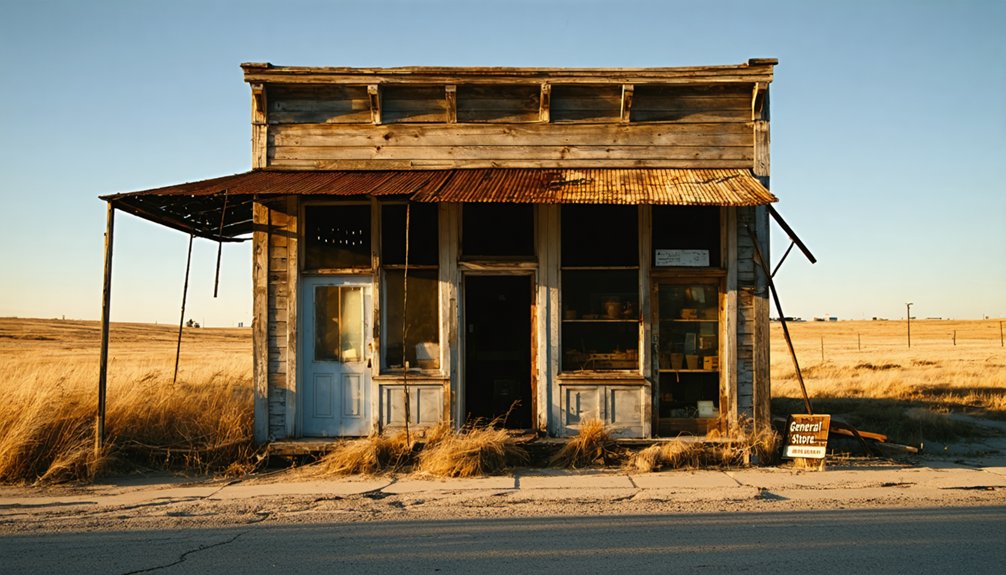You’ll find Potato Town‘s remnants near Deadwood in South Dakota’s Black Hills, where it emerged as a gold mining settlement in the late 1800s. The site once bustled with miners using placer and hard rock extraction methods, particularly yielding Potato Creek Johnny’s 7.346-troy-ounce gold nugget in 1929. Today, nature has reclaimed most traces of this mining camp’s cabins and mills, though its story weaves into the broader tapestry of Black Hills mining heritage.
Key Takeaways
- Potato Town was a late 19th-century mining settlement in South Dakota’s Black Hills region, near the famous boomtown of Deadwood.
- The site has no remaining standing structures, with nature reclaiming the former townsite near Potato Creek in the forested hills.
- Mining operations evolved from placer methods to hard rock mining, with the area known for Potato Creek Johnny’s 7.346-troy-ounce gold discovery.
- The ghost town’s exact history is difficult to document due to limited official records, incomplete census data, and missing post office information.
- Access to the former settlement is challenging via rural roads, with minimal visible traces of the original mining community remaining.
The Origins of Potato Town
Nestled in the historic Black Hills region of South Dakota, Potato Town emerged during the late 19th century amid the area’s gold rush fever.
You’ll find its remains near the famous mining boomtown of Deadwood, along routes once bustling with stagecoaches and freight wagons that brought prospectors and supplies into the region.
While the exact origin of the town naming remains unclear due to limited historical records, it’s likely tied to either community agriculture practices or local characteristics rather than mining alone.
The mystery behind Potato Town’s unusual name likely stems from farming roots rather than the gold mining that defined its neighbors.
Unlike its well-documented neighbor Deadwood, Potato Town developed as a smaller settlement supporting the area’s gold mining operations.
The town’s establishment followed typical patterns of the era, serving as both a mining community and a support hub for travelers along the region’s transportation routes.
Like Deadwood, which was born after miners discovered gold in southern Black Hills in 1874, Potato Town arose during this period of rapid regional development.
The area had long been sacred to Native Lakota tribes who were displaced as settlers and prospectors flooded into the region.
Life in a Black Hills Mining Camp
When prospectors flooded into the Black Hills during the late 1800s, they faced harsh realities of mining camp life that tested their resilience daily.
You’d have found yourself living in basic cabins or tents, battling the elements while dealing with unsanitary conditions and limited food supplies. The mining lifestyle centered around long, dangerous workdays in the mines, where you’d risk your life extracting gold from tons of rock. News of discoveries at French Creek drew thousands of hopeful miners to the region. A major gold strike by the Manuel brothers in 1876 fueled further dreams of riches.
Community structures emerged around saloons, dance halls, and gambling establishments, offering much-needed escape from the daily grind.
You’d encounter a diverse mix of immigrants and Americans from various regions, creating a multicultural but transient society. While informal justice and vigilantism often ruled the camps, miners still managed to build makeshift communities, organizing social events and ceremonies that reflected their varied backgrounds.
The Rise and Fall of Local Mining

You’ll find that early mining around Potato Town relied heavily on placer methods, with miners panning creek beds and using sluice boxes to separate gold from sediment.
The pioneering miners of Deadwood Creek found significant success extracting gold using these methods. By the 1880s, the shift to hard rock mining brought industrial-scale operations requiring deeper shafts, processing mills, and greatly more capital investment. The most famous local discovery came when Potato Creek Johnny found a massive 7.346-troy-ounce gold nugget in 1929.
The area’s mining economy ultimately faded as ore deposits became depleted, with the Dakota Tin and Gold Company’s 1950s mill fire marking a decisive end to large-scale operations.
Mining Methods Used
During the early days of Potato Town’s mining operations, prospectors initially focused on placer mining techniques to extract gold from creek beds and gravel deposits.
You’d find miners using basic tools like pans, rockers, and sluices to separate valuable gold particles from sediment. Similar to the Black Hills discoveries, multiple gold deposits were found in the area throughout the 1870s. By 1880, these placer deposits were largely exhausted, forcing a shift to hard rock mining methods.
The change to hard rock mining brought more industrial techniques to the area. The transition mirrored the success of the Homestake Mine, which became one of the world’s most productive gold sources.
Miners dug shafts and tunnels to reach gold-bearing quartz veins, initially crushing ore with sledgehammers or animal-powered arrastras. They’d later use power-driven crushers and stamping mills to process the ore more efficiently.
Once crushed, they’d extract gold through gravity concentration and amalgamation with mercury, while refractory gold required more complex chemical processes like chlorination or smelting.
Economic Impact Fades
As the 20th century dawned, Potato Town’s thriving mining economy began showing signs of decline.
Like many Black Hills mining communities, you’d have witnessed the economic shift unfold as resource depletion forced operations to scale back. The town’s story mirrors the broader pattern seen in places like Tinton and Hill City, where mining operations struggled to maintain profitability. The region’s early success peaked when gold output reached 35,400 ounces by 1959.
During World War II, mining restrictions hit the region hard, and many operations, including the Dakota Tin and Gold Company, never reopened.
Community resilience was tested as residents faced tough choices: adapt or relocate. While some towns like Deadwood found new life through tourism and gambling, others faded into ghost towns.
Today, you’ll find that tourism and historical preservation have become the economic lifeline for many former mining communities in the Black Hills.
Physical Remnants and Location Today
Located in Lawrence County, South Dakota, Potato Town‘s physical remnants have largely vanished into the forested hills and creek valleys of the Black Hills region.
If you’re planning to explore these abandoned landscapes, you’ll find minimal traces of the original settlement near Potato Creek, with no standing structures remaining. Unlike some preserved ghost towns in the area, such as Buffalo Ridge, you won’t find any maintained buildings or tourist facilities here. Similar to how the last resident of Capa, Philip O’Conor, used to share local history, there are no longer any inhabitants to tell Potato Town’s story.
The site’s accessibility is challenging, requiring travel on rural roads and prior knowledge of its location, as it’s rarely marked on general tourist maps.
For ghost town exploration enthusiasts, you’ll need to search carefully to spot any building foundations or footprints, as nature has reclaimed most of the former townsite.
Historical Significance in Dakota Territory

Though Potato Town was a relatively minor settlement within Dakota Territory, it emerged during a transformative period when the region’s political and economic landscape underwent dramatic changes.
You’ll find its story intertwined with the broader settlement patterns of Dakota Territory in the 1870s and 1880s, when the “Dakota Boom” brought waves of European and American settlers seeking opportunity in the newly organized territory.
Like many frontier communities, Potato Town’s fate was influenced by the expansion of railroads, the shift from fur trading to agricultural pursuits, and the complex dynamics of land speculation.
The settlement reflected the territory’s shifting demographics, as newcomers from Northern Europe and other U.S. territories established communities while maneuvering through the challenges of drought, market fluctuations, and the region’s evolving political structure.
Legacy in South Dakota’s Ghost Town Heritage
You’ll find Potato Town’s status among South Dakota’s ghost towns complicated by limited historical records and preservation challenges that make documenting its complete story difficult.
The site’s current preservation status relies heavily on photographic evidence and cultural memory, as many original structures have deteriorated or disappeared entirely.
Within the context of regional mining camps, Potato Town’s legacy connects to broader patterns of boom-and-bust cycles that characterized many South Dakota settlements in the early 20th century.
Historical Documentation Challenges
Despite extensive efforts to document South Dakota’s ghost towns, historians face significant challenges in preserving accurate records of these abandoned settlements.
You’ll find that varying ghost town definitions and documentation challenges create obstacles in accurately tracking Potato Town‘s history. The lack of official records, combined with limited historical sources, makes it difficult to piece together the complete story of this settlement.
When you’re researching Potato Town, you’ll encounter the common problems that plague ghost town documentation: incomplete census data, missing post office records, and unreliable secondary sources.
The town’s remote location further complicates access to historical sites, while community narratives and vintage photographs require careful verification. Cross-referencing information across multiple sources becomes essential to establish accurate historical facts about this forgotten South Dakota community.
Preservation Status Today
The current preservation status of Potato Town reflects its near-complete abandonment, with minimal physical remains marking its historical presence in South Dakota.
Unlike better-preserved ghost towns such as Tinton, you’ll find no formal preservation efforts or heritage recognition at this site.
Key preservation challenges and ghost town visibility issues include:
- No standing structures or maintained landmarks remain accessible for public viewing
- Absence of National Register of Historic Places designation or official heritage status
- Lack of organized preservation initiatives or interpretive infrastructure
- Site has largely reverted to natural landscape with limited historical traces
You won’t find guided tours or visitor facilities here, as the location exists primarily in historical records rather than as a tangible tourist destination.
The site’s deterioration places it among South Dakota’s more obscure ghost town locations.
Regional Mining Camp Context
While Potato Town’s mining heritage may seem modest, its story fits within South Dakota’s broader landscape of mining camps that flourished during the late 19th century.
You’ll find it shares common threads with other Black Hills settlements, where mining culture shaped everything from infrastructure to social dynamics. Like many camps, it emerged during a time when technological advances were shifting operations from simple placer mining to more complex hard-rock extraction methods.
The economic shift seen in Potato Town mirrors the broader pattern of South Dakota’s mining communities, where camps either evolved into permanent settlements or faded into ghost towns.
These camps weren’t just about mineral extraction – they were complete communities with blacksmith shops, boarding houses, and social halls that supported the mining operations and the workers who called them home.
Frequently Asked Questions
How Did Potato Town Get Its Unusual Name?
Like a golden thread weaving through history, you’ll find Potato Town’s unusual naming traces back to its location near Potato Creek, where prospectors struck gold during the Black Hills mining era.
Were There Any Notable Conflicts Between Miners and Native Americans Here?
You’ll find that miner-native relations around Potato Town reflected broader historical grievances in the Black Hills, with documented conflicts over treaty violations and sacred land rights during the 1870s gold rush.
What Types of Gold Mining Methods Were Primarily Used at Potato Town?
You’ll find that miners first used placer mining to extract gold from creek sediments, then shifted to hard rock mining in the 1880s when surface deposits became depleted.
Did Any Famous Old West Personalities Ever Visit Potato Town?
Though rumors swirl like dust in the wind, you won’t find any solid evidence of famous Old West visitors in historical records. Legends like Wild Bill and Calamity Jane stuck to nearby Deadwood.
What Happened to the Mining Equipment and Personal Belongings Left Behind?
You’ll find abandoned relics of mining equipment slowly deteriorating underground and personal items largely removed, though some artifacts of historical significance remain exposed to harsh weather and occasional scavenging.
References
- https://www.powderhouselodge.com/black-hills-attractions/fun-attractions/ghost-towns-of-western-south-dakota/
- https://www.sdpb.org/rural-life-and-history/2023-08-21/some-black-hills-ghost-towns-and-their-origins
- https://core.ac.uk/download/pdf/345016075.pdf
- https://icatchshadows.com/okaton-and-cottonwood-a-photographic-visit-to-two-south-dakota-ghost-towns/
- https://www.youtube.com/watch?v=_0WNYsFLSLA
- https://en.wikipedia.org/wiki/List_of_ghost_towns_in_South_Dakota
- https://www.blackhillsbadlands.com/blog/post/old-west-legends-mines-ghost-towns-route-reimagined/
- https://www.onlyinyourstate.com/experiences/south-dakota/capa-ghost-town-sd
- https://b1027.com/creepiest-coolest-ghost-towns-in-south-dakota-iowa-minnesota/
- https://www.deadwood.com/history/



